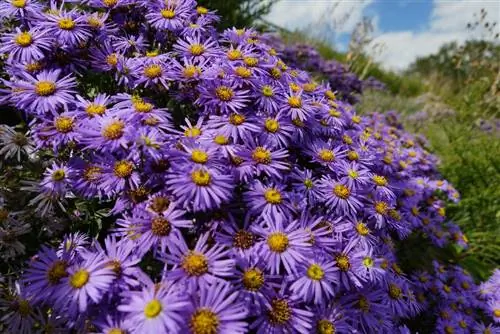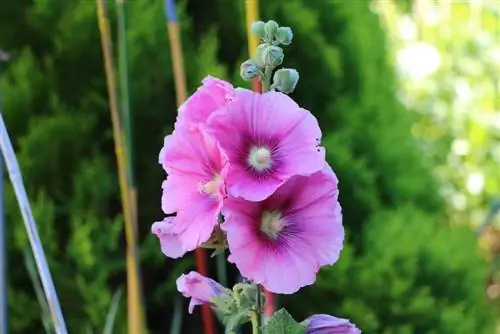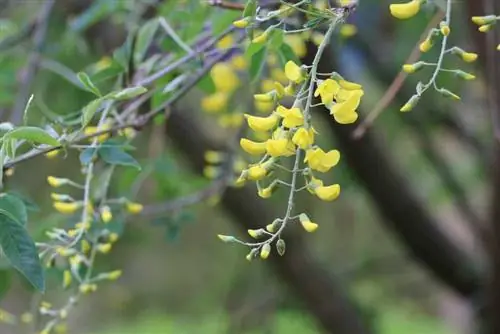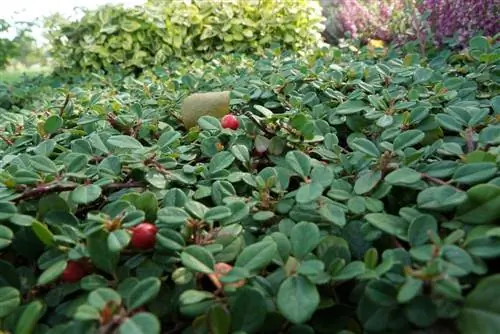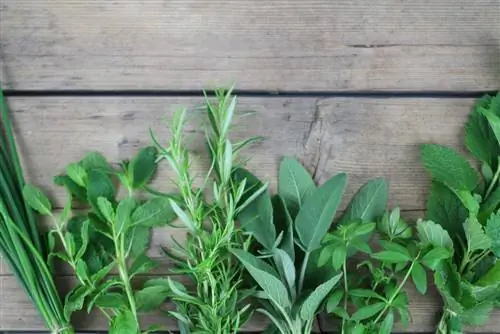- Author admin [email protected].
- Public 2023-12-17 03:39.
- Last modified 2025-01-24 12:45.
Places in the garden that are in full sun can not only get very hot in summer, they are usually also extremely dry. If the soil is also quite sandy and can hardly store water, the area seems at first glance to be completely unsuitable for plants. But a whole range of plants have also specialized in these extreme locations. Many plants only feel really comfortable when they are exposed to at least six to seven hours of sunlight and can cope well with prolonged drought. Now all you have to do is choose the right plants.
Plant selection
Adapting the location to the desired plant species usually involves a lot of effort and rarely leads to long-term success. It is better to select the plants according to the respective soil, nutrient, water and light conditions. Fortunately, the range of plants for sunny, dry and sandy locations is very large. Many of these plants are not only robust, but produce colorful flowers. These plants often require little water and nutrients, which is why they are perfect for sandy substrates. In addition to numerous wildflowers and Mediterranean perennials, there are also prairie grasses and succulent species to choose from.
Early flowering perennials for sunny, dry locations

Shortly after winter, some perennial plants produce their white or colorful flowers. Although the flowering of these plants usually doesn't last very long, they delight the gardener with the first accents in the otherwise dreary garden. The first buds appear as early as April.
- Alpine aster (Aster alpinus): low-growing wild species with heights of up to 25 cm, pink, violet or white flowers from May
- Pasqueflower (Pulsatilla vulgaris): lovable wild perennial from local dry grass, purple-blue flowers in April/May, height up to 30 cm
- Poppy (Papaver): 30 to 70 cm tall depending on the variety, often bright red flowers, flowering period from May
- Saxifrage (Saxifraga): ground-covering cushion plant with countless small flowers on upright stems in spring, some varieties like it a little shady and moist, others love the blazing sun
- Storksbill (Geranium): some varieties such as G. ibericum 'White Zigana', the Balkan cranesbill (G. macrorrhizum 'Bevan') and the brown cranesbill (G. phaeum) love sunny and dry locations
Summer flowering perennials for dry, full sun locations
Most perennials bloom from June or July, so the bed shines in all its glory. Despite drought and inhospitable conditions, the plants feel more comfortable the hotter the days get. Many of these robust plants produce flowers well into autumn and only need to be watered during long periods of drought.
- Balloon flower (Platycodon grandiflorum): extremely large bell-shaped flower in July/August, purple-blue flowers, height up to 40 cm, sprouts very late in spring
- Penstemon: tubular flowers on upright stems in June to August, height up to 100 cm
- Pale coneflower (Echinacea pallida): particularly drought-tolerant species, drooping, pink-red petals reminiscent of feather balls, growth height up to 120 cm, flowers in June/July
- Scented nettle (Agastache): the large variety of species ranges from low-growing species to bushy perennials, aromatic scent, violet flowers from June to October
- Gamander (Teucrium): long branched, upward-striving flower spikes up to 50 cm high between June and September, very drought tolerant, often purple-violet flowers
- Yellow coneflower (Echinacea paradoxa var. paradoxa): yellow flowers in June/July, for natural planting, very durable species, growth height up to 70 cm
- Scree carnation (Dianthus spiculifolius): from the Carpathians, cushion-shaped growth up to 15 cm high, wild carnation with green to blue frosted foliage, fine fringed flowers in June to October
- Charthouse carnation (Dianthus carthusianorum): native type of carnation that thrives even in the hottest and driest locations, grass-like foliage, heady inflorescences in a strong pinkish red, height 30 cm
- Sphere thistle (Echinops ritro 'Veitchs Blue'): noble variety of sphere thistle with bright blue spherical flowers, very compact type with growth heights of up to 60 cm
- Evening primrose (Oenothera): many different growth forms, some form carpets, others grow more upright, flower colors are very intense, some are winter green
- Northern Bluebell (Liatris borealis): valuable flowering plant with low prairie grasses, prefers dry but rather nutritious soils, flowers in June/July, growth height up to 50 cm
- Oxeye (Buphthalmum salicifolium): eye-catching, yellow-flowering wild perennial for dry edges and embankments, particularly beautiful as an extensive wild perennial planting, blooms between May and July, height 50 cm
- Palm lily (Yucca filamentosa): for an exotic touch in the garden, wintergreen plant with stiff rosettes, bell-like white inflorescence in July, height 50 cm
- Prairie mallow, marigold (Callirhoe involucrata var. tenuissima): small-sized speci alty (20 cm) for dry locations, bright pink flowers from July to September, feathery foliage
- Prairie candle (Gaura lindheimeri) vigorously growing perennial with white or pink flowers, height up to 130 cm
- Red sand thyme (Thymus serpyllus 'Coccineus'): forms flat carpets, wintergreen variety with pink flowers in June, ground cover with growth heights of up to 8 cm
- Red scabious flower (Knautia macedonica): abundant flowers in burgundy red from June to September, very popular butterfly flower with growth heights of up to 70 cm
- Sunflower (Helianthemum Hybride): available in many decorative flower colors, narrow, dark green foliage, full sun locations are mandatory, growth height up to 20 cm, blooms in June/July
- Spanish thistle (Eryngium bourgatii): light purple flower with a star base, works particularly well in combination with low grasses, blooms in July/August, growth height up to 40 cm
- Spur flower (Centranthus ruber var. coccineus 'Rosenrot'): loves warmth and light, grows even on very poor ground, self-seeding, pink-red flowers in June to August, height 50 cm
- Tennessee coneflower (Echinacea tennesseensis): special type of coneflower with standing pink petals, rare wild variety, blooms from June to September, height 70 cm
- Dwarf torch lily (Kniphofia triangularis subsp. triangularis): fine, fibrous leaves, yellow-orange flowers in July/August, heights up to 40 cm, winter protection necessary in rough locations
- Dwarf sand carnation (Dianthus arenarius f. nanus): fine-leaved and delicately flowering in May to June, wintergreen cushion plant, smells wonderful
Late flowering perennials for sunny, sandy places in the garden
While the summer bloomers are slowly withdrawing, the late-blooming plants are only really getting going. The following perennials decorate the prairie or rock garden until the first frosts:
- Mountain mint (Calamintha nepeta 'Triumphator'): blooms for a very long time (July to October) in white to pale blue and exudes a light mint scent, compact late bloomer for the foreground of dry planted areas, height 40 cm
- Myrtle aster, Septemberweed aster (Aster ericoides subsp. pansus 'Snowflurry'): low creeping growth (20 cm), numerous small flower stars and dark green foliage
- Dwarf wild aster (Aster sedifolius 'Nanus'): squat, clumpy growing wild aster with grey-blue, star-shaped flowers, height 40 cm
Succulent plants
In addition to the many perennials, there are also the succulent ground covers that bring a very special flair to dry and full-sun beds, wall crowns or rock gardens. You can also add greenery to garage or house roofs and require almost no maintenance.
- Houseleek (Sempervivum): silvery, wintergreen rosettes for very sunny and dry locations, flowering in June, heights between 5 and 15 cm (flower)
- Jupiterbeard (Jovibarba sobolifera): small, wintergreen rosettes, ground-covering creeper with growth heights of up to 5 cm
- stonecrop, sedum (sedum): yellow-leaved, purple or green-grey forms, attractive ground cover all year round with growth heights of 5 to 30 cm, there is no such thing as “too dry” for the plant, flowers in August/September
Grasses for dry, sunny beds
Whether as a loosening up in the rock garden or as a gap filler in the bed, grasses are always a very special eye-catcher. Especially when the dew droplets catch on the filigree leaves in the early morning, the leaves turn golden or reddish in autumn or the hoar frost forms bizarre shapes on the stalks in winter, the otherwise rather plain plants become something very special.
- Bearskin fescue (Festuca gautieri): very compact, cushion-shaped growth with dark green foliage, height 10 cm
- Blue fescue (Festuca cenerea): effective grass variety with blue-green foliage, cushion-shaped growth up to 15 cm high
- Bristled sedge (Carex eburnea): clumpy dry sedge, wintergreen, height 10 cm, somewhat weak in competition, but very durable
- Buffalo grass (Buchloe dactyloides): low, deciduous prairie grass, good as a weed suppressor, very robust, loves sandy soils, flowers in July, height 20 cm
- Lindheimer's drop seed (Muhlenbergia lindheimeri): decorative clump grass with wintergreen, blue-gray foliage, flower height up to 150 cm, good heat and drought tolerance, also hardy in wine-growing climate
- Mexican feather grass (Stipa tenuissimma): fine, overhanging leaves that sway in the wind, very beautiful even in winter, green-yellow foliage, height 40 cm
- Mosquito grass (Bouteloua gracilis): delicate, drought-tolerant grass from the short grass prairie of North America, good for loosening up cushion plants, very long-lasting, flowers in August/September, height 30 cm
- Purple love grass (Eragrostis spectabilis): low type of grass with growth heights of up to 30 cm, can be cultivated very well on sand, loves warmth, olive to purple foliage, flowers in August to November
- Transylvanian pearl grass (Melica transsilvanica): character grass for sunny, poor locations, creamy white inflorescences in May/June, height 40 cm
Sun-hungry shrubs

In addition to the perennials, there are also a variety of slightly woody plants that often originate in Mediterranean areas and therefore like to be in full sun in summer. Drought is not a problem for them. When choosing, however, you should pay attention to winter hardiness, because not all plants can tolerate frost. The following selection usually survives our winters without any problems and only needs to be protected from frost with some leaves or brushwood.
- Blue Rue (Perovskia atriplicifolia): particularly strong blue-violet flowers, compact growth, flowers between July and September, heights 60 to 80 cm
- Spiced thyme (Thymus vulgaris): whitish to pink flowering subshrub, flowering period June/July, height up to 30 cm
- Holywort (Santolina serratifolia): noble, fine silver foliage, small terminal spherical flowers, can also be grown as a hedge, requires light winter protection, height 50 cm
- Catmint (Nepeta grandiflora): bushy, compact growing plant with violet flowers in June/July and silver-grey foliage, height depending on the species between 40 and 80 cm
- Lavender (Lavandula angustifolia): compact, bushy growing plant with blue-green foliage, strong scent, flowers mostly blue-violet, heights between 35 and 70 cm
- Rosemary (Rosmarinus officinalis): aromatic, fragrant, hard foliage, flowering month in April/May, height 50 to 80 cm
- Sage (Salvia): small leaves in green or blue-green, compact bushy growing up to 50 cm, often lavender-blue flowers in June
- Black nettle (Ballota acetabulosa 'Filippi'): semi-shrubby, partly evergreen plant from the Mediterranean region with velvety soft, slightly golden shimmering foliage, height 50 cm
- Shrubby evening primrose (Calylophyus serrulatus): tolerates heat and drought without any problems, lemon-yellow flowers between June and October, which open during the day and close at night, still largely unknown plant, height 20 cm
Conclusion
The right planting can also be found for beds in the blazing sun, which also have very sandy soil and are therefore quite dry. Not only succulent plants feel at home here, but also a variety of Mediterranean subshrubs and perennials. Plants that grow in their natural range in prairies or on southern slopes of mountains are perfect for these site conditions. The selection of plants is therefore surprisingly large.

